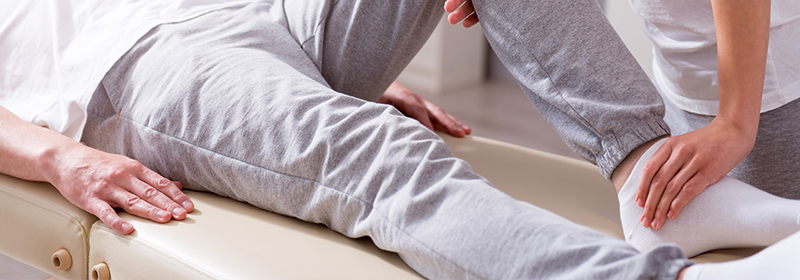Department Introduction
Physical Medicine and Rehabilitation | Our Speciality
:::

Electrotherapy chiefly treats various kinds of inflammation, such as De Quervain's disease, carpal tunnel syndrome, tennis elbow, knee osteoarthritis, plantar fasciitis, symptoms caused by intervertebral disc protrusion or nerve compression from bone spurs, and facial nerve paralysis.
Our Speciality
The department provides services such as outpatient consultation, hospitalization and rehabilitation, and consultation and rehabilitation for inpatients in other departments.
From stroke, brain trauma, spinal cord injury, cerebral palsy, and other central nervous system injuries; fractures, amputation, frozen shoulder, arthritis, sports injuries, and other limb dysfunction; ache problems such as dysfunction, upper and lower back pain, sciatica, carpal tunnel syndrome, and myofacial pain syndrome caused by cardiopulmonary disease or immobilization and disuse, to even children's development problems such as developmental delays in language and motor skills, sensory integration dysfunction , dysarthria, tarsoptosia, and abnormal gaits, rehabilitation department staff can tailor the rehabilitation program to suit patients’ condition and needs, striving to provide rehabilitation medical services, so that patients can unlock their maximum potential to overcome obstacles caused by injuries as soon as possible, and fulfil their optimal life and professional functions.
Physical therapy

Electrotherapy chiefly treats various kinds of inflammation, such as De Quervain's disease, carpal tunnel syndrome, tennis elbow, knee osteoarthritis, plantar fasciitis, symptoms caused by intervertebral disc protrusion or nerve compression from bone spurs, and facial nerve paralysis.
The main target group of orthopedic rehabilitation is patients with limb swelling and stiffness due to fractures, frozen shoulder with limited joint angles, and knee and hip joint replacement.
Cardiopulmonary therapy is mainly used to treat cardiopulmonary diseases, such as chronic obstructive pulmonary disease and systemic functional decline induced by valve replacement and chronic nephropathy.
Nerve rehabilitation chiefly targets the patients with a stroke, cerebral trauma, spinal cord injury, burns, sports injuries, hand injuries, fractures, degenerative diseases, cranial nerve lesions, amputation, central or peripheral nerve damage.
Pediatric physiotherapy and sensory integration therapy are aimed at the children with congenital diseases such as cerebral palsy, Down's syndrome, and developmental delays, sensory integration dysfunction, attention deficit or hyperactivity arising from unknown congenital causes or preterm birth, and other sensory integration problems.
Occupational therapy
Occupational therapy is the use of various activities as a medical treatment to help diagnose or train patients to achieve functional self-reliance. The therapy analyzes various physical and psychological characteristics of these activities and select and modify them appropriately so as to suit the needs of patients, solve their special issues, promote functional recovery, enable them to return to their jobs or to take care of themselves in their daily life, and live happily by helping them to maximize their potential in work, social, and family life.
Occupational therapy items and services include:
- neurophysiological occupational therapy
- developmental disorder children's occupational therapy
Neurophysiological occupational therapy
The therapy targets the patients with cerebrovascular diseases (stroke), cerebral trauma, spinal cord injury, burns, sports injuries, hand injuries, fractures, degenerative diseases, cranial nerve lesions, amputation, central or peripheral nerve damage.
We use neural development, motion learning, ergonomics, biomechanics, and sensorimotor theories to arrange activity therapy to improve the quality of life of the case.
We train patients' daily life functions, including sitting up, turning over, personal hygiene, diet, wearing, and action, while through various activities, promoting the patient's muscle strength, joint motion, flexibility and coordination of hands and feet movement, maintenance of correct postures, and cognitive training.
In addition, we can solve inconveniences to patients and enable the patients to maximize their independence by participating in the design of auxiliary tools and the production of splints.
Occupational therapy for children with developmental disorders
The therapy is aimed at the patients with cerebral palsy, Down's syndrome, developmental delays or obstacles, mental retardation, autism, encephalopathy or genetic diseases, preterm birth, hyperactivity, mood disorders, sensory integration dysfunction, and learning disabilities.
We use motor learning, sensory integration, biomechanics, neural development, visual perception development, and other theoretical frameworks to carry out evaluations and analyses and design appropriate activities for timely training, in an effort to resolve problems faced by young children, increase their interest in external affairs, enhance their motivation and concentration, and help them build good interpersonal relationships and improve their learning ability.
Speech therapy
Despite some individual differences in language development, it is generally developed based on age. Therefore, when the development of children's language skills starts late and progresses more slowly, and the final development level is lower than the average child, they are language delay or atypical language development.
Speech therapy services include:
- assessment, diagnosis, and treatment of children or adults with language and communication impairments;
- assessment, diagnosis, and treatment of dysphagia;
- the design and application of communication aids, and
- medical and social resources consultation in relation to language disorders, communication impairments, and dysphagia.
As far as children with developmental delays are concerned, mouth functions and feeding are fairly common issues for parents. The treatment of abnormal functions of the mouth should be meted out to them as early as possible. If children are sensitive to some foods with different textures, they will stop trying various foods and will not be able to develop some important skills, such as oral sensation and fine movements in the oral cavity. For this reason, it is very important to establish normal oral sensation and mature oral movements early in eating experience, and these sensory and motor abilities are the first step to speak clearly and take care of themselves independently in the future.
▲
